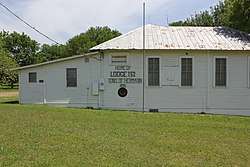Sons of Hermann
The Order of the Sons of Hermann, also known as Hermann Sons and by its German name as Der Orden der Hermanns-Soehne or Hermannssöhne, is a mutual aid society for German immigrants that was formed in New York City on July 20, 1840,[1][2] and remains active in the states of California, Ohio, and Texas today. Open to members of any heritage today, the order provides low-cost insurance and mutual aid and has historically promoted the preservation of German language and traditions.
Der Orden der Hermanns-Soehne | |
 | |
| Motto | Freundschaft, Liebe, Treue (German) "Friendship, Love and Loyalty"[lower-alpha 1] |
|---|---|
| Established | 20 July 1840 |
Area served | United States of America |
| Website | www www www |
History

%2C_Holyoke%2C_Massachusetts.jpg)
The Sons of Hermann was formed by Dr. Philip Merkel, George Heiner, John Blatz, A. Auer, R. Schwendel, W. Kohler, and Philipp Germann on the Lower East Side,[2][4] in response to anti-German sentiment during a period of heavy German immigration to the United States. One account, published in the St. Paul Morning Call in 1896, is that the order was founded after the funeral procession for a German was hindered and the mourners insulted by nativists, prompting protest meetings of German Americans, at one of which a speaker said another Hermann (Arminius) was needed to protect the Germans from their enemies.[5] It was an offshoot of the Odd Fellows.[6] By 1848 the organization had grown to six groups with 800 members, and on December 25, 1848, a national grand lodge was formed in Milwaukee.[1] Hundreds of lodges were organized during the nineteenth century; by 1895 there were about 30,000 members,[2] and in 1896 there were Grand Lodges in California, Connecticut, Colorado, Illinois, Kansas, Massachusetts, Michigan, Minnesota, Missouri, New Jersey, Ohio, Pennsylvania, Texas and Washington in addition to New York, as well as scattered members in 15 other states with a total membership of 90,000.[5] A German-language account ten years after that mentions affiliates in Canada and in Germany itself.[7] However, like all things German, the order declined sharply in popularity with the outbreak of World War I.[8]
The order's symbolic colors are black, red and gold, representing German unity: black for ignorance, prejudice and indifference; red for the light and enlightenment spread by German culture and the German spirit; and gold for true freedom, which man arrives at through knowledge and labor.[5] The order never had degrees. It has had rituals since its inception; at one point the Roman Catholic Church refused church burial to members of the Sons of Hermann because of their ritual.[9] But by the 1970s neither the initiation rite nor the burial rite was required. The burial rite mentions that the departed is now with the Almighty, but the order does not limit its membership to believers in a supreme being.[10]
German Jews participated fully in the Sons of Hermann; the order's insurance fund was led by Jacob Brandeis and Rabbi Emanuel Gerechter, the former also directing the order's choral group in Milwaukee.[11] At one point the order had a female auxiliary called the Daughters of Hermann, open to the wives, mothers, sisters and daughters of the Sons.[12]
Harmonia Lodge No. 1 in San Antonio was the first Sons of Hermann lodge to offer its members non-profit life insurance (proposed in 1873).[13] Starting on July 1, 1875, the national organization required members to purchase a life insurance policy.[14] This is now a major feature of membership; ritual initiation is not required.[15]
Minnesota
Hermann Monument, New Ulm, Minnesota
Under the leadership of Julius Berndt, then national secretary, the Sons of Hermann paid for an American monument to Hermann modeled on the Hermannsdenkmal in Germany. It was completed in 1897 and is located in New Ulm, Minnesota, where Berndt was head of the local chapter.[16] Following the First World War, anti-German sentiment remained in America and the local order disbanded thereafter, donating the statue and grounds to the City of New Ulm in 1929.[17]
Texas


In 1861 the first lodge in Texas, Harmonia Lodge No. 1, was organized in San Antonio. On March 27, 1890, the Texas grand lodge was formed, consisting of Harmonia Lodge of San Antonio and seven other lodges in Austin, Taylor, Temple, Waco, La Grange, Brenham, and Houston, with a combined membership of 242. 92 more lodges were formed in the next year. In 1896 the first sister lodge for women was dedicated in Sherman, and in 1920 the first mixed lodge for both men and women, in San Antonio. In 1920 the Order of the Sons of Hermann in Texas, which by then was wealthier and had more members than all other lodges elsewhere in the United States combined, declared itself independent of the national order.[1]
The Texas order phased out the German language (Texas German) in favor of English by 1937. By 1965 only half the membership was of German heritage, and by 1994 membership was open to all.[1] Membership grew as restrictions were lifted.[15]
The Texas order had 80,000 members in 1995,[18] and as of 2008 had more than 74,000 members in more than 140 lodges.[14]
The Texas order has operated a retirement home in Comfort since 1916[19] and summer youth camps, also on property it owns in Comfort, since 1954. Local lodges offer scholarships to students in their communities.[1]
Sons of Hermann Hall, Dallas
The Sons of Hermann Hall in Deep Ellum, Dallas was built in 1910 by the four Dallas lodges and is currently used by two lodges as well as being available for rent.[20] It is a popular venue for the local music scene.[21] A profile of it by Ray Wylie Hubbard appears in Pat Green's Dance Halls & Dreamers.[22]
Notes
- Variations exist between state organizations, sometimes written as "Friendship, Love, Fidelity", or alternately Freundschaft, Liebe, Humanitat or "Friendship, Love, and Humanity"
References
- Fritz Schilo, "Sons of Hermann", Handbook of Texas Online, Texas State Historical Society, retrieved August 14, 2013.
- "Die Hermann's Soehne: An Order with an Honorable Record for Benevolence: Works of Charity Quietly Done: A Society Founded to Foster the German Language and Customs – A Statue to Hermann, the Teuton Warrior," New York Times, May 19, 1895, p. 21. (pdf)
- "Sons of Hermann Open New Home; Building in South Summer Street, Holyoke, Visited by Many Guests; Structure cost $30,000; Mayor White Among Those Who Deliver Addresses and Greet Friends of Lodge". Springfield Union. Springfield, Mass. October 13, 1912. p. 12.
- According to Albert Clark Stevens, The Cyclopædia of Fraternities, 2nd ed., New York: Treat, 1907, p. 282, the fifth and seventh names are R. Schivendel and Philipp Hermann. He and the New York Times both have "Dr. Philip Merkel" as the first name.
- Stevens, p. 283.
- Stanley Nadel, Little Germany: Ethnicity, Religion, and Class in New York City, 1845–80, University of Illinois Press, 1990, ISBN 0-252-01677-7, p. 111.
- Georg Schuster, Die Geheimen Gesellschaften, Verbindungen und Orden, Volume 2 Leipzig: Theodor Leibing, 1906, p. 511.
- Germany and the Americas: Culture, Politics, and History, ed. Thomas Adam, ABC-CLIO, 2005, ISBN 1-85109-628-0 p. 985 .
- Kathleen Neils Conzen, Immigrant Milwaukee, 1836–1860: Accommodation and Community in a Frontier City, Harvard University Press, 1976, ISBN 0-674-44436-1 p. 169.
- Alvin J. Schmidt with Nicholas Babchuk, Fraternal Organizations, Greenwood encyclopedia of American institutions 3, Westport, Connecticut: Greenwood, 1980, ISBN 978-0-313-21436-3, p. 153.
- Avraham Barkai, Branching Out: German-Jewish Immigration to the United States, 1820–1914. Ellis Island Series. Holmes & Meier, 1994, ISBN 0-8419-1152-5, p. 184.
- Stevens, pp. 283–84.
- "From Folk Hero to Fraternalism," Archived 2009-10-04 at the Wayback Machine Sons of Hermann Hall, Dallas, December 16, 2008. Accessed October 18, 2009.
- "History," Hermann Sons Fraternal Insurance, 2008. Accessed October 18, 2009.
- "Order of Sons of Hermann," Stichting Argus. Accessed October 18, 2009.
- Adam, pp. 985–86.
- Bannister, Megan (January 9, 2017). "Meet Hermann the German in New Ulm, Minnesota". Olio in Iowa. Archived from the original on March 20, 2019.
- Alan Axelrod, The International Encyclopedia of Secret Societies and Fraternal Orders, New York: Facts on File, 1997, ISBN 978-0-8160-2307-3, p. 229.
- "Retirement Home," Hermann Sons Fraternal Insurance, 2008. Accessed October 18, 2009. Admission requires membership and twenty years' life insurance premiums.
- "The History of the Sons of Hermann Hall," Archived 2009-10-04 at the Wayback Machine Sons of Hermann Hall, Dallas, December 16, 2008. Accessed October 18, 2009.
- Vanessa Quilantan, "The 12 Best New Year's Eve Concerts In Dallas: $20 to $200", Blogs, Dallas Observer, December 23, 2013.
- Luke Gilliam, Pat Green's Dance Halls & Dreamers, University of Texas, 2008, ISBN 978-0-292-71876-0.
External links
- Hermann Sons Fraternal Insurance, Texas
- Gross Loge des Staates California, Grand Lodge of California (in German)
- State Grand Lodge of Ohio
- Sons of Hermann Hall, Dallas
- Sons of Hermann Hall Calendar
- 90th anniversary, Harmonia Lodge No. 1, Order of the Sons of Hermann, San Antonio, Texas, July 6, 1951 : a short history
- Neunzehnhundertste Jahresfeier der Schlacht im Teutoburger Walde : Gedenkblätter an das Fest der Deutschen von Californien. San Francisco, 1. und 8. August 1909, unter Leitung der Grossloge des Ordens der Hermanns-Söhne Order of the Sons of Hermann. California. Grossloge [San Francisco : Order of the Sons of Hermann]